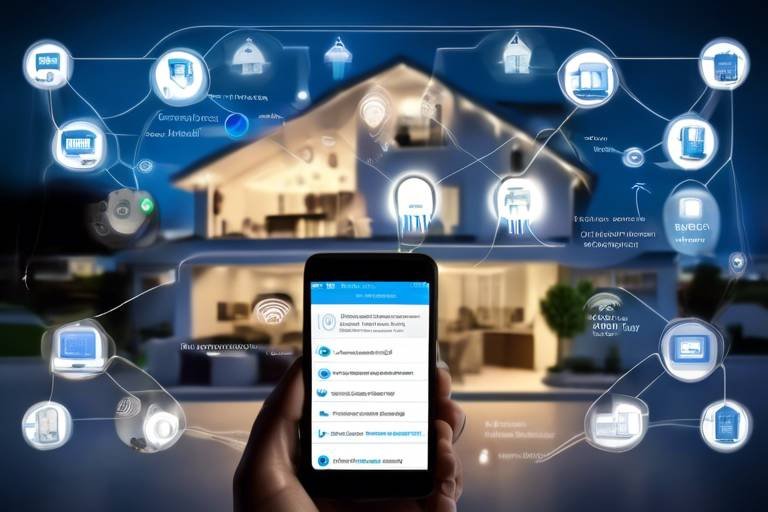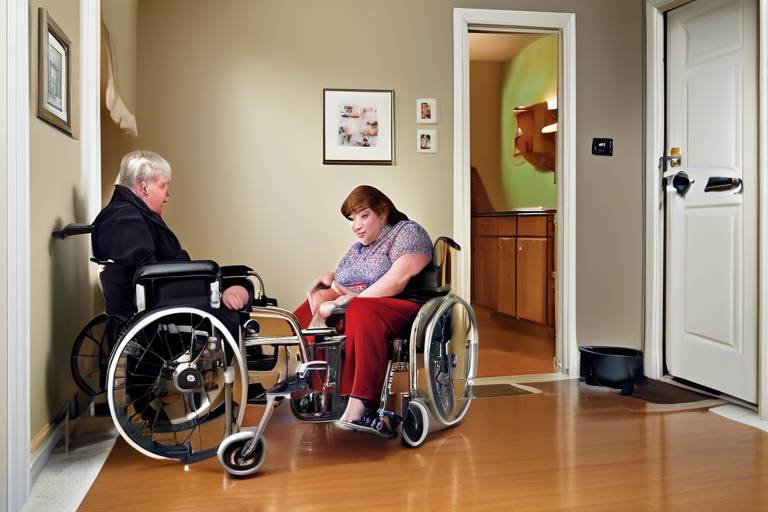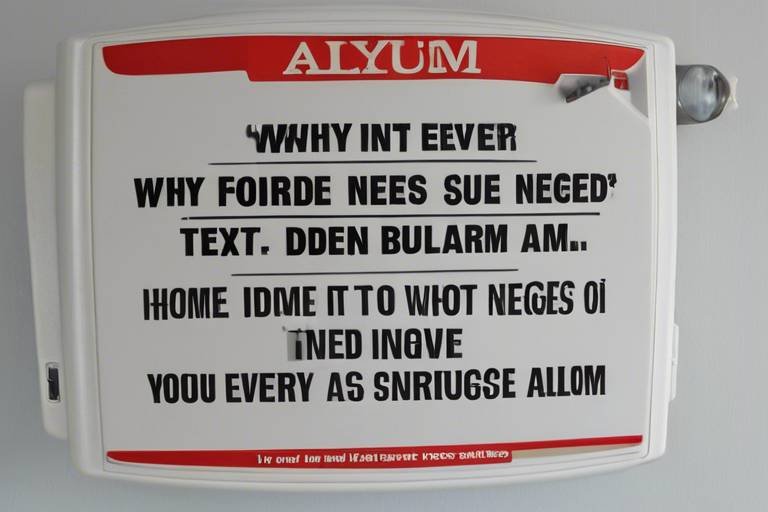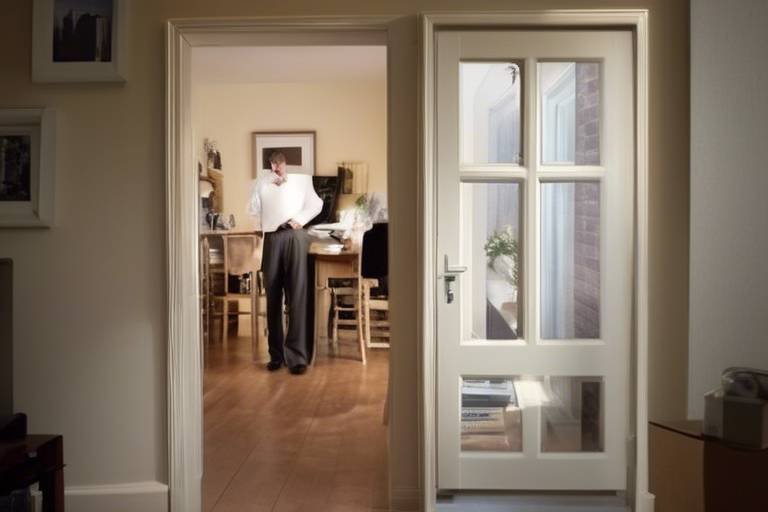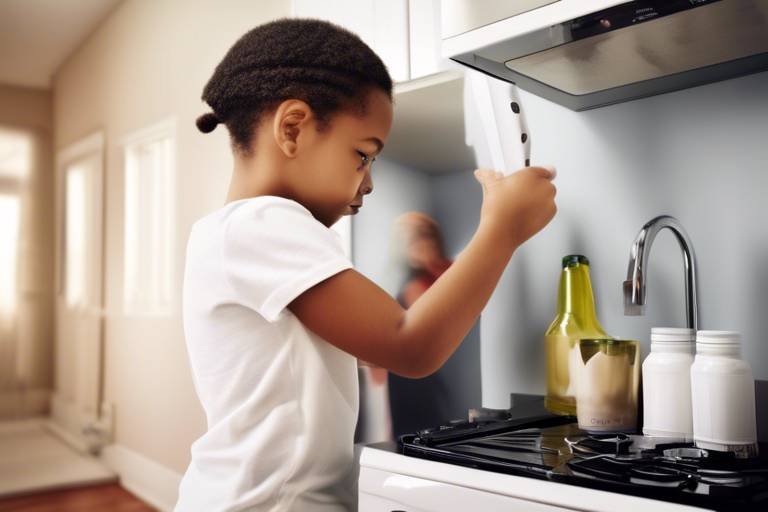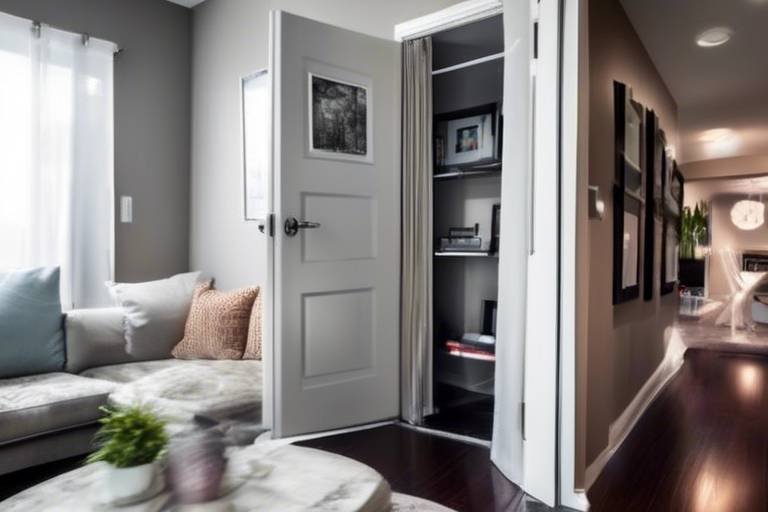Smart Homes and Security - The Connection
In today's fast-paced world, the concept of a smart home is no longer just a futuristic dream; it's a reality that many of us are embracing. Imagine walking into your home, and with a simple voice command, the lights turn on, the thermostat adjusts to your preferred temperature, and your favorite playlist starts playing. But while the convenience of smart technology is undeniable, there's an equally important aspect we must consider: security. This article explores the intricate connection between smart home technology and security, examining how innovations enhance safety, the challenges involved, and the future landscape of connected living environments.
At the heart of smart homes lies a network of devices and systems that communicate with each other through the internet. This connectivity allows for remote management and automation, making our lives easier and more efficient. However, it also opens up new avenues for potential security threats. As we dive deeper into this topic, we'll uncover how smart home technology can bolster our security measures, the types of devices available, and the best practices to follow for a secure living environment.
But before we get into the nitty-gritty details, let's take a moment to consider why home security matters so much. After all, our homes are our sanctuaries, a place where we should feel safe and protected. With rising crime rates and increasing instances of home invasions, it's more crucial than ever to integrate robust security measures within our smart home systems. The peace of mind that comes from knowing your home is secure is invaluable, and smart technology can play a significant role in achieving that.
As we explore the various types of smart security devices available, such as cameras, alarms, and smart locks, it's essential to understand their functionalities and how they contribute to a comprehensive home security strategy. Each device brings unique features to the table, enhancing our ability to monitor and respond to potential threats. For instance, smart cameras not only provide real-time surveillance but also alert homeowners to any unusual activities, while smart locks offer the convenience of keyless entry and remote access control.
However, the journey into the world of smart home security isn't without its challenges. The very connectivity that makes these devices so appealing also introduces vulnerabilities. Cybersecurity threats, such as hacking, can compromise the safety of our homes if we are not vigilant. Therefore, it's imperative to adopt best practices for securing our smart homes, which include regular software updates, creating strong passwords, and effectively managing our devices.
In conclusion, as we navigate the evolving landscape of smart home technology, it's essential to remain proactive about security. By understanding the connection between smart homes and security, we can leverage technology to create a safer living environment for ourselves and our loved ones. So, are you ready to take the plunge into the world of smart homes while keeping security at the forefront? Let's explore the details further!

Understanding Smart Home Technology
Smart home technology is revolutionizing the way we interact with our living spaces. Imagine a home that knows when you're coming back from work, adjusts the temperature to your liking, and even locks the doors behind you. This is not just a dream anymore; it’s a reality thanks to the integration of various devices and systems that connect to the internet. These innovations not only enhance convenience but also significantly boost security. By allowing homeowners to monitor and control their properties remotely, smart home technology creates a safer and more efficient living environment.
At its core, smart home technology comprises a variety of components that work together seamlessly. These include:
- Smart appliances: Devices like refrigerators, ovens, and washing machines that can be controlled via your smartphone.
- Smart lighting: Systems that allow you to adjust brightness and color from anywhere, even set schedules or automate them based on your routines.
- Smart security systems: Cameras, alarms, and locks that provide real-time updates and alerts to keep your home safe.
- Smart thermostats: Devices that learn your temperature preferences and optimize energy usage.
These components are typically controlled through a central hub or app, which means you can manage everything from one place. This interconnectedness is what makes smart homes so appealing. But, how do these technologies enhance security specifically? Well, the integration of smart devices allows for real-time monitoring and alerts. For instance, if a motion sensor detects movement outside your home, you can receive an instant notification on your phone, enabling you to take immediate action.
Moreover, smart home technology can be programmed to simulate your presence even when you're away. By scheduling lights to turn on and off or playing music at certain times, you can deter potential intruders who might think twice about targeting a home that appears occupied. This level of control and automation provides homeowners with a sense of security that traditional systems often lack.
However, with great power comes great responsibility. While smart home technology offers numerous benefits, it also raises questions about privacy and security. As more devices connect to the internet, the potential for hacking and unauthorized access increases. Therefore, understanding how these technologies work and implementing robust security measures is essential for protecting your connected home.
In conclusion, smart home technology is not just about convenience; it's about creating a safer living environment. By understanding the components that make up this technology and how they interact, homeowners can take full advantage of the security enhancements it offers. As we continue to embrace this digital age, staying informed and proactive will be key to ensuring our homes remain safe and secure.

The Importance of Home Security
When we think about our homes, we often picture them as safe havens, places where we can unwind and be ourselves. However, the reality is that home security is a critical aspect of maintaining that peace of mind. With rising crime rates and an ever-evolving landscape of threats, protecting your personal property has never been more essential. Imagine coming home after a long day, only to find your belongings have been ransacked. It’s a nightmare no one wants to experience, and that’s where robust home security systems come into play.
Home security is not just about safeguarding your physical possessions; it's about ensuring the safety of your family and creating a sense of tranquility in your living environment. The significance of integrating security measures within smart home systems cannot be overstated. In fact, a comprehensive security strategy can deter potential intruders and provide you with real-time updates about your home’s status. This proactive approach is crucial in today’s world, where threats can come in various forms, from burglaries to cyber intrusions.
Consider the following risks homeowners often face:
- Burglaries: A significant concern for many, as homes without security systems are often targeted.
- Fire Hazards: Unmonitored electrical devices can lead to devastating fires.
- Environmental Threats: Floods or gas leaks can occur without warning, putting lives at risk.
Integrating smart technology into home security systems allows homeowners to monitor their properties remotely, receive alerts on suspicious activities, and even control access to their homes from anywhere in the world. This level of control is not just a luxury; it’s becoming a necessity. With devices like smart cameras and locks, homeowners can have peace of mind knowing they are taking proactive steps to protect their loved ones and their possessions.
Moreover, the importance of home security extends beyond just physical safety. It significantly impacts mental well-being. When you know your home is secure, you can relax, enjoy your time with family, and focus on what truly matters. The connection between feeling safe and mental health is profound; after all, a secure home fosters a nurturing environment where families can thrive.
In conclusion, the importance of home security cannot be overlooked. As technology continues to advance, integrating smart home systems with security measures is not just a trend but a necessity for modern living. It’s about creating a fortress around your home, ensuring that your sanctuary remains just that—a safe place for you and your family.
Q1: What are the most common types of home security systems?
A1: Common types include burglar alarms, surveillance cameras, smart locks, and motion detectors.
Q2: How can I improve my home security on a budget?
A2: Simple measures like installing deadbolts, using outdoor lighting, and securing windows can enhance security without breaking the bank.
Q3: Are smart home security devices easy to install?
A3: Many smart devices are designed for easy installation, often requiring no professional help. However, some may need a bit more technical know-how.
Q4: What should I look for in a smart security camera?
A4: Look for features like high-resolution video, night vision, motion detection, and cloud storage options.
Q5: Can I integrate my smart home security system with other smart devices?
A5: Yes, most smart home security systems can be integrated with other devices, allowing for a cohesive smart home experience.

Types of Smart Security Devices
When it comes to protecting your home, understanding the different types of smart security devices available is crucial. These devices not only enhance your security but also provide convenience and peace of mind. Let's dive into the main categories of smart security devices that can transform your home into a fortress of safety.
First up, we have smart cameras. These devices are like having a vigilant eye on your property at all times. Equipped with features such as motion detection, night vision, and two-way audio, smart cameras allow homeowners to monitor their premises in real-time. You can receive alerts directly on your smartphone whenever motion is detected, ensuring you never miss a beat. Additionally, many smart cameras offer cloud storage options, allowing you to review footage anytime, anywhere. Imagine being able to check in on your home while you're at work or on vacation!
Next, let's talk about smart locks. Gone are the days of fumbling for keys or worrying about losing them. Smart locks provide keyless entry, enabling you to unlock your door with just a tap on your smartphone or through a simple voice command. This technology not only enhances convenience but also increases security. You can grant temporary access to guests or service providers without needing to hand over a physical key. However, it's essential to be aware of potential vulnerabilities, such as hacking risks, which can compromise your home's security.
In addition to cameras and locks, there are smart alarms that play a pivotal role in home security. These systems can detect unauthorized entry and alert you instantly, often integrating with other smart devices for a comprehensive security solution. Some alarms even have features like environmental monitoring, detecting smoke or carbon monoxide, providing a multi-layered approach to safety.
Another noteworthy mention is the smart doorbell. This device combines the functions of a traditional doorbell with a camera, allowing you to see who’s at your door from anywhere. You can communicate with visitors through your smartphone, even if you’re not at home. This is particularly useful for package deliveries or unexpected guests. With a smart doorbell, you can enhance your home’s security while maintaining a friendly neighborhood vibe.
To summarize, the landscape of smart security devices is diverse, offering a range of options to suit different needs. Here's a quick overview of the types of devices we discussed:
| Device Type | Key Features |
|---|---|
| Smart Cameras | Real-time monitoring, motion detection, cloud storage |
| Smart Locks | Keyless entry, remote access, temporary access codes |
| Smart Alarms | Unauthorized entry detection, environmental monitoring |
| Smart Doorbells | Video feed, two-way audio, remote communication |
By integrating these devices into your home, you can create a robust security system that not only protects your property but also enhances your daily life. In the ever-evolving world of technology, staying informed about these devices is key to making the best choices for your home security.
- What is the most important smart security device for a home? While it depends on individual needs, smart cameras and locks are often considered essential for comprehensive security.
- Are smart security devices easy to install? Most smart security devices come with user-friendly installation guides, making it easy for homeowners to set them up without professional help.
- How can I ensure my smart security devices are secure? Regularly update your device software, use strong passwords, and enable two-factor authentication whenever possible.

Smart Cameras
In the age of technology, have revolutionized the way we think about home security. These devices are not just about capturing images; they are sophisticated tools designed to keep your home safe and sound. Imagine being able to monitor your property in real-time, no matter where you are in the world. That’s the power of smart cameras!
One of the standout features of smart cameras is their motion detection capability. This means that the camera can identify movement and send alerts directly to your smartphone. Picture this: you're at work, and your camera detects someone lingering around your front porch. Instantly, you receive a notification, allowing you to take action if necessary. This feature not only enhances your security but also gives you peace of mind, knowing you’re always in the loop.
Moreover, many smart cameras offer cloud storage options. This means that even if someone manages to tamper with your device, the footage is safely stored in the cloud, accessible only to you. This feature is crucial for providing evidence in case of a break-in or any suspicious activity. Instead of worrying about losing vital footage, you can rest easy knowing that your camera has your back.
Another exciting aspect of smart cameras is their night vision capabilities. Ever tried to see what's happening outside your home in the dark? It can be nearly impossible without proper lighting. Smart cameras equipped with night vision technology allow you to see clearly even in low-light conditions. This feature ensures that your home is monitored 24/7, regardless of the time of day.
Smart cameras also come with various integration options. They can be linked to your smart home ecosystem, allowing you to control them through voice commands or mobile apps. Imagine saying, "Hey Google, show me the front door," and within seconds, you’re viewing a live feed. This level of integration not only enhances convenience but also makes managing your home security systems a breeze.
However, it’s essential to choose the right camera for your needs. When selecting a smart camera, consider factors such as resolution, field of view, and whether it offers two-way audio. For instance, some cameras allow you to communicate with visitors or deter intruders by using built-in speakers. This can be particularly useful when you’re away from home but want to give the impression that someone is there.
In summary, smart cameras are a pivotal element of modern home security. They offer real-time monitoring, motion detection, cloud storage, and integration with other smart devices, all of which contribute to a safer living environment. As technology continues to evolve, these cameras will undoubtedly become even more advanced, providing homeowners with innovative solutions to protect their properties.
- What is the main benefit of using smart cameras?
Smart cameras provide real-time monitoring and alerts, enhancing your home security and peace of mind. - Can smart cameras work without Wi-Fi?
Most smart cameras require a Wi-Fi connection to function effectively, as they rely on internet connectivity for features like remote access and cloud storage. - Are smart cameras easy to install?
Yes, many smart cameras are designed for easy installation, often requiring just a few steps to set up and connect to your home network. - How do I ensure my smart camera is secure?
Regularly update the camera's software, use strong passwords, and enable two-factor authentication when available to enhance security.

Smart Locks
Smart locks represent a remarkable leap forward in home security technology, offering homeowners a blend of convenience and protection that traditional locks simply can't match. Imagine being able to unlock your front door with just a tap on your smartphone or granting access to a friend or service provider while you're miles away. This is the magic of smart locks! They utilize advanced technology to replace the conventional key and give you control like never before.
One of the most appealing features of smart locks is their keyless entry. This means you can say goodbye to fumbling around for keys in your bag or pocket, especially when your hands are full. With options like fingerprint recognition, keypad entry, or even mobile app access, smart locks make entering your home a breeze. This is particularly useful for families with children or elderly members who may struggle with traditional keys.
However, while smart locks offer many benefits, they also come with their own set of concerns. For instance, what happens if the battery dies? Most smart locks have a backup key option, but it's essential to know how to access it in emergencies. Additionally, hacking is a real threat; therefore, it's crucial to choose a reputable brand that prioritizes security features. Look for locks that offer encryption and regular software updates to keep potential vulnerabilities at bay.
When considering a smart lock, you should also evaluate its integration with your existing smart home ecosystem. Many smart locks can connect with other devices, such as smart cameras and alarms, providing a comprehensive security solution. For example, if your smart lock detects that someone is trying to tamper with it, it can trigger your security cameras to start recording. This interconnectedness enhances your overall security strategy and provides peace of mind.
In summary, smart locks are not just a trendy gadget; they are a significant advancement in home security. They offer unparalleled convenience, enhanced security features, and the ability to integrate with other smart devices. However, it’s essential to stay informed about potential vulnerabilities and choose a model that fits your lifestyle and security needs.
- What happens if my smart lock battery dies? Most smart locks have a backup key option or a way to charge them temporarily.
- Can I control my smart lock remotely? Yes, most smart locks allow remote access through a mobile app.
- Are smart locks safe from hacking? While no device is entirely hack-proof, choosing a reputable brand with strong security features can significantly reduce risks.
- Do smart locks work during a power outage? Many smart locks operate on battery power, so they should continue to function during power outages.

Challenges in Smart Home Security
As we embrace the convenience of smart home technology, we must also confront the challenges it brings to our security. While these devices offer unparalleled ease of use and automation, they also introduce a range of vulnerabilities that can be exploited by malicious actors. One of the most pressing concerns is the risk of hacking. Many smart devices are connected to the internet, making them potential targets for cybercriminals. Imagine your home security camera being hacked, allowing someone to spy on your daily activities. This is not just a hypothetical scenario; it has happened to many unsuspecting homeowners.
Moreover, the sheer number of devices in a smart home ecosystem can complicate security management. Each device may have its own set of vulnerabilities, and keeping track of them can be overwhelming. For instance, a smart thermostat, security camera, and smart lock could all have different firmware updates and security protocols. This fragmentation can lead to gaps in protection if homeowners fail to regularly update their devices. In fact, a recent study indicated that over 60% of smart home devices are not updated regularly, leaving them exposed to potential threats.
Another significant challenge is the issue of default settings. Many smart devices come with factory-set passwords that are often weak and easily guessable. If users do not take the time to change these settings, they are essentially rolling out the welcome mat for hackers. For example, if a smart lock is still using its default password, it can be easily compromised, granting unauthorized access to your home. This highlights the importance of educating homeowners about the risks associated with default settings and the necessity of customizing them for better security.
Furthermore, the integration of various smart devices can create a false sense of security. Homeowners may believe that simply having a smart lock or security camera is enough to deter intruders. However, if these devices are not properly configured or secured, they can become liabilities rather than safeguards. It’s crucial to understand that smart devices are not a replacement for traditional security measures, but rather an enhancement. Homeowners should consider a comprehensive security strategy that combines smart technology with conventional methods.
To sum it up, the challenges in smart home security are multifaceted and require ongoing vigilance. Homeowners must remain aware of the potential risks and take proactive steps to mitigate them. This includes regularly updating devices, changing default settings, and not relying solely on smart technology for security. By staying informed and adopting best practices, we can enjoy the benefits of smart homes while keeping our families and belongings safe.
- What are the most common security risks associated with smart homes?
Common risks include hacking, weak default passwords, and poorly managed device updates. - How can I protect my smart home devices from hackers?
Use strong, unique passwords, enable two-factor authentication, and regularly update your device firmware. - Are smart locks safer than traditional locks?
Smart locks offer convenience and remote access but require proper security measures to be truly effective. - What should I do if my smart device is hacked?
Immediately change your passwords, disconnect the device from the internet, and consult the manufacturer for advice.

Best Practices for Securing Smart Homes
In the age of smart homes, where convenience meets technology, ensuring the security of your connected devices is paramount. With an array of gadgets at our fingertips, it’s easy to overlook the potential vulnerabilities that come with them. Just think about it: your smart thermostat, lights, and even your refrigerator could be targeted by cybercriminals if not properly secured. Therefore, implementing best practices is essential for safeguarding your smart home environment.
First and foremost, regular software updates are crucial. Manufacturers frequently release updates to patch security flaws and enhance functionality. Neglecting these updates can leave your devices open to attacks. Set a reminder to check for updates regularly, or better yet, enable automatic updates if the option is available. This simple step can significantly bolster your home’s security posture.
Next, let’s talk about the importance of creating strong passwords. A weak password is like leaving your front door wide open for intruders. Instead, opt for a combination of uppercase letters, lowercase letters, numbers, and special characters. For instance, instead of using “password123,” consider something more complex like “P@ssw0rd!2023.” Additionally, using a password manager can help you keep track of your numerous passwords securely without the need to remember each one.
Another vital practice is to secure your Wi-Fi network. Ensure that your Wi-Fi is password-protected and that you’re using WPA3 encryption, the latest and most secure protocol available. Change the default network name (SSID) and password to something unique and not easily guessable. This way, you’re not just protecting your network but also the devices connected to it.
It's also advisable to limit device access. Not every device in your home needs to be connected to the internet. Assess which devices truly require connectivity and disable those that don’t. This reduces the number of entry points that hackers can exploit. Furthermore, consider creating a separate network for your smart devices. This way, even if one device is compromised, your primary network remains secure.
Lastly, familiarize yourself with the security features of each device you own. Some devices come with built-in security measures that can be activated. For instance, many smart cameras offer two-factor authentication (2FA) and encryption options. Make sure to enable these features to add an extra layer of protection. Remember, knowledge is power when it comes to securing your smart home!
By following these best practices, you can significantly enhance the security of your smart home. It’s all about being proactive rather than reactive. After all, in a world where technology continues to evolve, staying one step ahead of potential threats is the best defense.
- What should I do if my smart device gets hacked? If you suspect that your device has been compromised, immediately disconnect it from the internet, change your passwords, and check for any unauthorized activity.
- Are smart home devices safe? While smart home devices can be secure, their safety largely depends on how well they are configured and maintained. Following best practices significantly minimizes risks.
- How often should I update my smart devices? Regularly check for updates at least once a month, or enable automatic updates if available. Keeping your devices updated is key to security.

Regular Software Updates
In the ever-evolving landscape of technology, keeping your smart home devices updated is not just a good idea; it’s a necessity. Regular software updates serve as a crucial line of defense against potential threats. Think of it like getting a flu shot every year. Just as vaccines protect you from seasonal viruses, software updates protect your devices from emerging cybersecurity threats. These updates often include security patches, bug fixes, and even new features that can enhance the functionality of your devices. Neglecting to update your smart home technology can leave you vulnerable to hackers and other malicious entities.
Moreover, manufacturers are constantly working to improve their products. When you install an update, you’re not just fixing problems; you’re also benefiting from the latest advancements in technology. For instance, a simple update might improve your smart camera's motion detection capabilities or enhance your smart lock's encryption methods. This is especially important as cyber threats become more sophisticated. The reality is that if you’re not updating your devices regularly, you may be leaving the door wide open for cyber intruders.
Here are a few key reasons why regular software updates are essential for securing your smart home:
- Enhanced Security: Updates often include critical security fixes that protect against vulnerabilities discovered since the last update.
- Improved Functionality: Many updates come with new features that can enhance the performance and usability of your devices.
- Bug Fixes: Addressing known issues can prevent malfunctions that could compromise your home’s security.
To ensure that you never miss an important update, consider setting your devices to automatically download and install updates whenever they become available. This way, you can rest easy knowing that your smart home is equipped with the latest security measures without having to remember to check for updates manually. However, it's always a good practice to periodically check the manufacturer's website or app for any important announcements regarding your devices.
In conclusion, think of regular software updates as a digital shield for your smart home. They not only protect your devices but also enhance their performance and longevity. So, make it a habit to stay updated, because in the world of smart home technology, an ounce of prevention is worth a pound of cure.
Q1: How often should I update my smart home devices?
A1: It's best to check for updates at least once a month, or set your devices to update automatically whenever possible.
Q2: What happens if I don't update my devices?
A2: Failing to update can leave your devices vulnerable to security threats, bugs, and performance issues.
Q3: Are software updates really necessary?
A3: Yes, they are essential for maintaining security, improving functionality, and fixing bugs in your smart home devices.

Creating Strong Passwords
In today's digital age, where our lives are increasingly intertwined with technology, creating strong passwords is not just a good practice—it's a necessity. Think of your password as the front door to your smart home; if it's weak, you're basically leaving the door wide open for intruders. A strong password acts as a fortress, protecting your personal information and the security of your connected devices.
So, what makes a password strong? A strong password typically contains a mix of uppercase and lowercase letters, numbers, and special characters. This combination makes it much harder for hackers to guess or crack your password using brute force methods. For instance, instead of using something simple like "Password123", which is shockingly easy to guess, you might create a password like "M0nkey$@f3ty!2023". This not only meets the complexity criteria but also makes it memorable by associating it with a fun phrase or image.
Here are some key tips to help you create robust passwords:
- Avoid common words: Stay away from easily guessable words or phrases, such as your name, birthdate, or "123456".
- Use a password manager: These tools can generate and store complex passwords for you, so you don't have to remember them all.
- Change passwords regularly: Make it a habit to update your passwords every few months. This reduces the risk of long-term exposure if a password is compromised.
Additionally, consider using two-factor authentication (2FA) wherever possible. This adds an extra layer of security by requiring not only your password but also a second form of verification, such as a code sent to your mobile device. It’s like having a deadbolt on your door in addition to a regular lock—just a little extra protection can make a world of difference.
Lastly, remember that no password is entirely foolproof. Regularly monitoring your accounts for suspicious activity can help you catch any potential breaches early. If you ever suspect that your password has been compromised, change it immediately. Taking these proactive steps will help ensure that your smart home remains a safe haven in an increasingly connected world.
Q1: How often should I change my passwords?
A1: It's advisable to change your passwords every 3 to 6 months, especially for sensitive accounts. Regular updates reduce the risk of prolonged unauthorized access.
Q2: What are some signs that my account may have been compromised?
A2: Look out for unusual login attempts, unfamiliar devices accessing your account, or changes to your account settings that you didn't make. If you notice anything suspicious, change your password immediately.
Q3: Can I use the same password for multiple accounts?
A3: It's not recommended. If one account is compromised, using the same password elsewhere can put all your accounts at risk. Always use unique passwords for different accounts.
Frequently Asked Questions
-
What is smart home technology?
Smart home technology refers to devices and systems that connect to the internet, allowing homeowners to manage and automate various functions remotely. This includes everything from lighting and heating to security systems, making life more convenient and secure.
-
How do smart security devices enhance home safety?
Smart security devices, like cameras and alarms, provide real-time monitoring and alerts, helping homeowners respond quickly to potential threats. They can also be integrated with other smart home systems for a comprehensive security strategy, ensuring your home is always protected.
-
What types of smart security devices are available?
There are several types of smart security devices, including:
- Smart cameras for surveillance
- Smart locks for keyless entry
- Smart alarms that alert you to intrusions
Each device plays a unique role in enhancing the overall security of your home.
-
Are smart locks safe to use?
Smart locks offer increased convenience by allowing keyless entry and remote access control. However, they can have vulnerabilities, so it’s crucial to use strong passwords and keep the device software updated to mitigate risks.
-
What are the common challenges in smart home security?
Some common challenges include hacking risks, device vulnerabilities, and the potential for unauthorized access. It's essential to implement strong security measures to protect your smart home ecosystem.
-
How can I secure my smart home?
Securing your smart home involves several best practices, such as:
- Regularly updating device software
- Creating strong, unique passwords
- Managing device settings and permissions
These steps help ensure your devices remain secure and function optimally.
-
Why are software updates important for smart devices?
Software updates are crucial because they often include security patches that protect against newly discovered vulnerabilities. Keeping your devices updated helps maintain their performance and security within your smart home.
-
What tips can you provide for creating strong passwords?
To create strong passwords, consider the following tips:
- Use a mix of uppercase and lowercase letters, numbers, and symbols
- Avoid common words or easily guessable information
- Consider using a password manager to keep track of your passwords securely
Strong passwords are a fundamental aspect of protecting your smart home devices.

